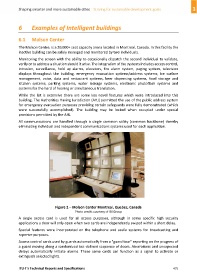Page 485 - Shaping smarter and more sustainable cities - Striving for sustainable development goals
P. 485
6 Examples of Intelligent buildings
6.1 Molson Center
The Molson Centre, is a 20,000+ seat capacity arena located in Montreal, Canada. In this facility the
inactive building can be safely managed and monitored by two individuals.
Monitoring the screen with the ability to occasionally dispatch the second individual to validate,
verify or to address a situation should it arise. The integration of the systems includes access control,
intrusion, surveillance, hold up alarms, elevators, fire alarm system, paging system, television
displays throughout the building, emergency evacuation systems/address systems, ice surface
management, voice, data and restaurant systems, beer dispensing systems, food storage and
kitchen systems, parking systems, water leakage systems, electronic photoflash systems and
systems for the hard of hearing or simultaneous translation.
While the list is extensive there are some key novel features which were introduced into this
building. The Authorities Having Jurisdiction (AHJ) permitted the use of the public address system
for emergency evacuation purposes providing certain safeguards were fully demonstrated (which
were successfully accomplished). The building may be locked when occupied under special
provisions permitted by the AHJ.
All communications are handled through a single common utility (common backbone) thereby
eliminating individual and independent communications systems used for each application.
Figure 2 – Molson Center Montreal, Quebec, Canada
Photo credit: courtesy of IBI Group
A single access card is used for all access purposes, although in some specific high security
applications a door will only open when two cards are independently swiped within a short delay.
Special features were incorporated on the telephone and audio systems for broadcasting and
reporter purposes.
Access control cards used by guards automatically from a "guard tour" reporting on the progress of
a guard moving along a randomized but defined sequence of doors. Aberrations and unexpected
delays automatically initiate alarms. These same cards can function as a signal to activate or
extinguish selected lights.
ITU‐T's Technical Reports and Specifications 475

